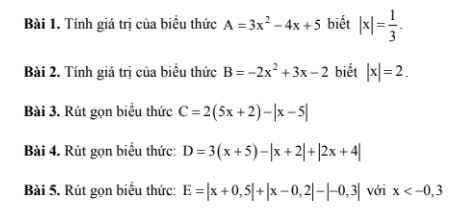Gia
Hãy nhập câu hỏi của bạn vào đây, nếu là tài khoản VIP, bạn sẽ được ưu tiên trả lời.


Bài 1 :
a) \(123456789+729=\text{123457518}⋮2\)
⇒ Số trên là hợp số
b)\(5.7.8.9.11-132=\text{27588}⋮2\)
⇒ Số trên là hợp số
Bài 2 :
a) \(P+2\&P+4\) ;à số nguyên tố
\(\Rightarrow\dfrac{P+2}{P+4}=\pm1\)
\(\Rightarrow\left[{}\begin{matrix}\dfrac{P+2}{P+4}=1\\\dfrac{P+2}{P+4}=-1\end{matrix}\right.\)
\(\Rightarrow\left[{}\begin{matrix}P+2=P+4\\P+2=-P-4\end{matrix}\right.\) \(\Rightarrow\left[{}\begin{matrix}0.P=2\left(x\in\varnothing\right)\\2.P=-6\end{matrix}\right.\)
\(\Rightarrow P=-3\)
Câu b tương tự
a,123456789+729=123457518(hợp số)
b,5x7x8x9x11-132=27588(hợp số)
Bài 2,
a,Nếu P=2=>p+2=4 và p+4=6 (loại)
Nếu P=3=>p+2=5 và p+4=7(t/m)
P>3 => P có dạng 3k+1 hoặc 3k+2(k ϵn,k>0)
Nếu p=3k+1=>p+2=3k+3 ⋮3( loại)
Nếu p=3k+2=>p+4=3k+6⋮3(loại)
Vậy p=3 thỏa mãn đề bài
b,Nếu p=2=>p+10=12 và p+14=16(loại)
Nếu p=3=>p+10=13 và p+14=17(t/m)
Nếu p >3=>p có dạng 3k+1 hoặc 3k+2
Nếu p=3k+1=>p+14=3k+15⋮3(loại)
Nếu p=3k+2=>p+10=3k+12⋮3(loại)
Vậy p=3 thỏa mãn đề bài.

\(\dfrac{55}{6x11}+\dfrac{55}{11x16}+\dfrac{55}{21x16}+\dfrac{55}{21x26}+\dfrac{55}{31x26}\)
\(=55\left(\dfrac{1}{6x11}+\dfrac{1}{11x16}+\dfrac{1}{21x16}+\dfrac{1}{21x26}+\dfrac{1}{31x26}\right)\)
\(=55\left(\dfrac{1}{5}x\left(\dfrac{1}{6}-\dfrac{1}{11}\right)+\dfrac{1}{5}x\left(\dfrac{1}{11}-\dfrac{1}{16}\right)+\dfrac{1}{5}x\left(\dfrac{1}{16}-\dfrac{1}{21}\right)+\dfrac{1}{5}x\left(\dfrac{1}{21}-\dfrac{1}{26}\right)+\dfrac{1}{5}x\left(\dfrac{1}{26}-\dfrac{1}{31}\right)\right)\)
\(=55x\dfrac{1}{5}x\left(\dfrac{1}{6}-\dfrac{1}{11}+\dfrac{1}{11}-\dfrac{1}{16}+\dfrac{1}{16}-\dfrac{1}{21}+\dfrac{1}{21}-\dfrac{1}{26}+\dfrac{1}{26}-\dfrac{1}{31}\right)\)
\(=11x\left(\dfrac{1}{6}-\dfrac{1}{31}\right)=11x\left(\dfrac{31-6}{186}\right)=11x\dfrac{25}{186}=\dfrac{275}{186}\)
C=\(\dfrac{55}{6\cdot11}\)+\(\dfrac{55}{11\cdot16}\)+\(\dfrac{55}{16\cdot21}\)+\(\dfrac{55}{21\cdot26}\)+\(\dfrac{55}{26\cdot31}\)
=\(\dfrac{1}{6}\)-\(\dfrac{1}{11}\)+\(\dfrac{1}{11}\)-\(\dfrac{1}{16}\)+\(\dfrac{1}{16}\)-\(\dfrac{1}{21}\)+\(\dfrac{1}{21}\)-\(\dfrac{1}{26}\)+\(\dfrac{1}{26}\)-\(\dfrac{1}{31}\)
=\(\dfrac{1}{6}\)-\(\dfrac{1}{31}\)=\(\dfrac{25}{186}\)

\(a.\dfrac{7}{19}+\dfrac{12}{19}=\dfrac{7+12}{19}=\dfrac{19}{19}=1\)
\(b.\dfrac{5}{13}+\dfrac{4}{13}=\dfrac{5+4}{13}=\dfrac{9}{13}\)
\(c.\dfrac{24}{11}-\dfrac{13}{11}=\dfrac{24-13}{11}=\dfrac{11}{11}=1\)
\(d.\dfrac{35}{8}-\dfrac{19}{8}=\dfrac{35-19}{8}=\dfrac{16}{8}=2\)
a,\(\dfrac{7}{19}\)+\(\dfrac{12}{19}\)=\(\dfrac{19}{19}\)=1
b,\(\dfrac{5}{13}\)+\(\dfrac{4}{13}\)=\(\dfrac{9}{13}\)
c,\(\dfrac{24}{11}\)-\(\dfrac{13}{11}\)=\(\dfrac{11}{11}\)=1
d,\(\dfrac{35}{8}\)-\(\dfrac{19}{8}\)=\(\dfrac{16}{8}\)=2

a,91-5(5+x)=61
=>25+5x=91-61=30
=>5x=30-25=5
=>x=1
b,\([\left(x+34\right)-50]\)x2=56
=>(x+34)-50=56:2=28
=>x+34=28+50=78
=>x=78-34=44.
c,1045-\([2015-\left(3x-24\right)]\)=5
=>2015-(3x-24)=1045-5=1040
=>3x-24=2015-1040=975
=>3x=975+24=999
=>x=999:3=333
d,\([195-\left(3x-27\right)]\)x39=4212
=>195-(3x-27)=4212:39=108
=>3x-27=195-108=87
=>3x=87+27=117
=>x=39
e,30-3(x-2)=18
=>30-3x+6=18
=>30-3x=18-6=12
=>3x=30-12=18
=>x=18:3=6
a) \(...\Rightarrow5\left(5+x\right)=91-61=30\)
\(\Rightarrow\left(5+x\right)=30:5=6\Rightarrow x=6-5=1\)
b) \(...\Rightarrow\left(x+34\right)-50=56:2=28\)
\(\Rightarrow\left(x+34\right)=28+50=78\Rightarrow x=78-34=44\)
c) \(...\Rightarrow2015-\left(3x-24\right)=1045-5=1040\)
\(\Rightarrow\left(3x-24\right)=2015-1040=975\)
\(\Rightarrow3x=975+24=999\Rightarrow x=999:3=333\)
d) \(...\Rightarrow195-\left(3x-27\right)=4212:39=108\)
\(\Rightarrow\left(3x-27\right)=195-108=87\)
\(\Rightarrow3x=87+27=114\Rightarrow x=114:3=38\)
e) \(...\Rightarrow3\left(x-2\right)=30-18=12\Rightarrow x-2=12:3=4\)
\(\Rightarrow x=4+2=6\)

Ta có:
\(\dfrac{4}{12}=\dfrac{1}{3}\)
\(\dfrac{5}{20}=\dfrac{1}{4}\)
\(\dfrac{21}{35}=\dfrac{3}{5}\)
\(\dfrac{17}{34}=\dfrac{1}{2}\)
Vậy \(\dfrac{17}{34}=\dfrac{1}{2}\)

Bài 1:
$|x|=\frac{1}{3}\Rightarrow x=\frac{1}{3}$ hoặc $x=\frac{-1}{3}$
Nếu $x=\frac{1}{3}$ thì $A=3x^2-4x+5=3.(\frac{1}{3})^2-4.\frac{1}{3}+5=4$
Nếu $x=\frac{-1}{3}$ thì $A=3x^2-4x+5=3.(\frac{-1}{3})^2-4.\frac{-1}{3}+5=\frac{20}{3}$
Baif 2:
$|x|=2\Rightarrow x=\pm 2$
Nếu $x=2$ thì $B=-2x^2+3x-2=-2.2^2+3.2-2=-4$
Nếu $x=-2$ thì $B=-2x^2+3x-2=-2.(-2)^2+3(-2)-2=-16$
Bài 3:
Nếu $x\geq 5$ thì:
$C=2(5x+2)-(x-5)=10x+4-x+5=9x+9$
Nếu $x<5$ thì:
$C=2(5x+2)-(5-x)=10x+4-5+x=11x-1$

Để đơn giản hóa biểu thức, chúng ta cần áp dụng thuộc tính phân phối và đơn giản hóa mọi giá trị tuyệt đối.
Đầu tiên, hãy phân phối 3 cho các điều khoản bên trong dấu ngoặc đơn:
3(4x-1) = 12x - 3
Tiếp theo, hãy đơn giản hóa biểu thức giá trị tuyệt đối |x-2|:
|x-2| có thể dương hoặc âm tùy thuộc vào giá trị của x. Nếu x lớn hơn 2 thì |x-2| = x-2. Nếu x nhỏ hơn 2 thì |x-2| = -(x-2) = -x + 2.
Do đó, chúng ta có hai trường hợp cần xem xét:
Trường hợp 1: x > 2
Trong trường hợp này, |x-2| = x-2. Vì vậy, biểu thức trở thành:
12x - 3 - (x-2)
Đơn giản hóa hơn nữa:
12x - 3 - x + 2 = 11x - 1
Trường hợp 2: x < 2
Trong trường hợp này, |x-2| = -x + 2. Vậy biểu thức trở thành:
12x - 3 - (-x + 2)
Đơn giản hóa hơn nữa:
12x - 3 + x - 2 = 13x - 5
Do đó, biểu thức đơn giản hóa là:
Nếu x > 2: 11x - 1
Nếu x < 2: 13x - 5
...

1292 : 81 = 15 dư 77
2095 : 18 = 116 dư 7